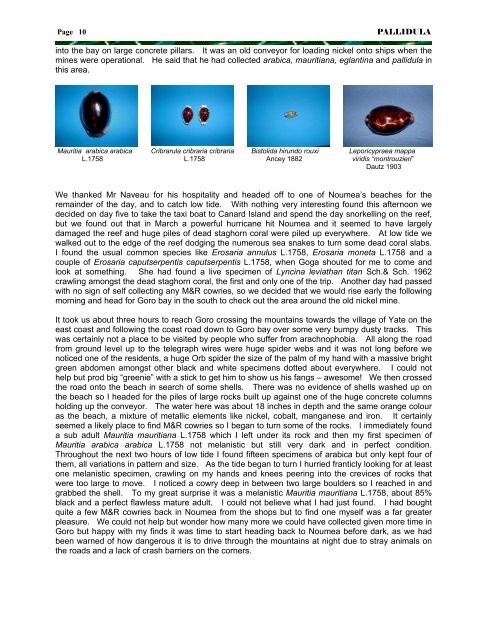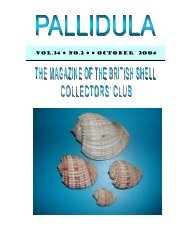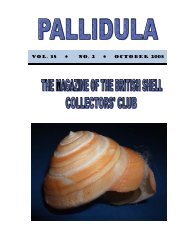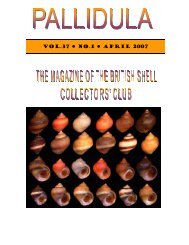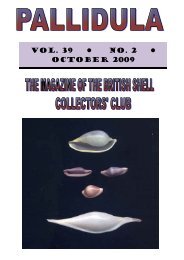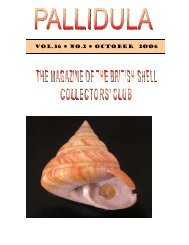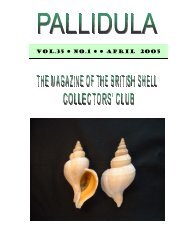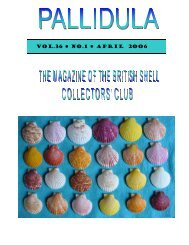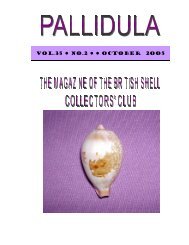April, 2004 - British Shell Collectors' Club
April, 2004 - British Shell Collectors' Club
April, 2004 - British Shell Collectors' Club
Create successful ePaper yourself
Turn your PDF publications into a flip-book with our unique Google optimized e-Paper software.
Page 10PALLIDULAinto the bay on large concrete pillars. It was an old conveyor for loading nickel onto ships when themines were operational. He said that he had collected arabica, mauritiana, eglantina and pallidula inthis area.Mauritia arabica arabica Cribrarula cribraria cribraria Bistolida hirundo rouxi Leporicypraea mappaL.1758 L.1758 Ancey 1882 viridis “montrouzieri”Dautz 1903We thanked Mr Naveau for his hospitality and headed off to one of Noumea’s beaches for theremainder of the day, and to catch low tide. With nothing very interesting found this afternoon wedecided on day five to take the taxi boat to Canard Island and spend the day snorkelling on the reef,but we found out that in March a powerful hurricane hit Noumea and it seemed to have largelydamaged the reef and huge piles of dead staghorn coral were piled up everywhere. At low tide wewalked out to the edge of the reef dodging the numerous sea snakes to turn some dead coral slabs.I found the usual common species like Erosaria annulus L.1758, Erosaria moneta L.1758 and acouple of Erosaria caputserpentis caputserpentis L.1758, when Goga shouted for me to come andlook at something. She had found a live specimen of Lyncina leviathan titan Sch.& Sch. 1962crawling amongst the dead staghorn coral, the first and only one of the trip. Another day had passedwith no sign of self collecting any M&R cowries, so we decided that we would rise early the followingmorning and head for Goro bay in the south to check out the area around the old nickel mine.It took us about three hours to reach Goro crossing the mountains towards the village of Yate on theeast coast and following the coast road down to Goro bay over some very bumpy dusty tracks. Thiswas certainly not a place to be visited by people who suffer from arachnophobia. All along the roadfrom ground level up to the telegraph wires were huge spider webs and it was not long before wenoticed one of the residents, a huge Orb spider the size of the palm of my hand with a massive brightgreen abdomen amongst other black and white specimens dotted about everywhere. I could nothelp but prod big “greenie” with a stick to get him to show us his fangs – awesome! We then crossedthe road onto the beach in search of some shells. There was no evidence of shells washed up onthe beach so I headed for the piles of large rocks built up against one of the huge concrete columnsholding up the conveyor. The water here was about 18 inches in depth and the same orange colouras the beach, a mixture of metallic elements like nickel, cobalt, manganese and iron. It certainlyseemed a likely place to find M&R cowries so I began to turn some of the rocks. I immediately founda sub adult Mauritia mauritiana L.1758 which I left under its rock and then my first specimen ofMauritia arabica arabica L.1758 not melanistic but still very dark and in perfect condition.Throughout the next two hours of low tide I found fifteen specimens of arabica but only kept four ofthem, all variations in pattern and size. As the tide began to turn I hurried franticly looking for at leastone melanistic specimen, crawling on my hands and knees peering into the crevices of rocks thatwere too large to move. I noticed a cowry deep in between two large boulders so I reached in andgrabbed the shell. To my great surprise it was a melanistic Mauritia mauritiana L.1758, about 85%black and a perfect flawless mature adult. I could not believe what I had just found. I had boughtquite a few M&R cowries back in Noumea from the shops but to find one myself was a far greaterpleasure. We could not help but wonder how many more we could have collected given more time inGoro but happy with my finds it was time to start heading back to Noumea before dark, as we hadbeen warned of how dangerous it is to drive through the mountains at night due to stray animals onthe roads and a lack of crash barriers on the corners.


